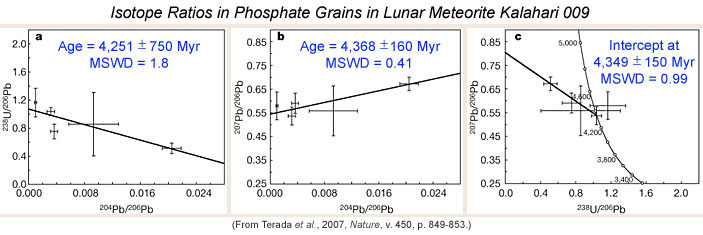
Additional Notes for "Chips Off an Old Lava Flow"
Reference: Terada, K., Anand, M., Sokol, A. K., Bischoff, A., and Sano, Y. (2007) Cryptomare Magmatism 4.35 Billion Years Ago Recorded in Lunar Meteorite Kalahari 009. Nature, v. 450, p. 849-853.
 |
|
Graphs of isotope ratios in phosphate minerals measured by ion microprobe in a basalt fragment in Kalahari 009. The relatively well-defined lines (called isochrons) in graphs a and b yield ages for a particular set of isotopes. The diagram on the right (c) shows a projection from three-dimensions, so uses all isotopic data, and gives an age of 4.35 ± 0.15 billion years, which Terada and his colleagues suggest is the best estimate of the age of the lava flows represented in Kalahari 009. The uncertainty in the age is based on the uncertainties in the individual measurements (see error bars) and is at the 95% confidence level. (MSWD is the mean square of weighted deviate, a measure of the scatter in the data.)
|
The advantages of the three dimensional diagram, figure c, are the following:
- It is not necessary to know the isotopic composition of initial lead.
- Both 238U and 235U decay schemes are used at the same time, yielding a smaller justifiable age uncertainty for the U-Pb systematics.
- In some cases, two kinds of chronological information (formation age and alteration age) are simultaneously obtained. This is very important for lunar rocks, because some rocks might have been affected by secondary events such as impacts. If the U-Pb system were even slightly disturbed, the data will not plot on a straight line in figure c. For Kalahari 009, the data plot along a straight line, indicating that there was no heating event strong enough to affect the U-Pb system. (In many cases, data not plotting on a straight line tells us about both the formation age and the alteration age.)
Back to: Chips Off an Old Lava Flow.
December, 2007
